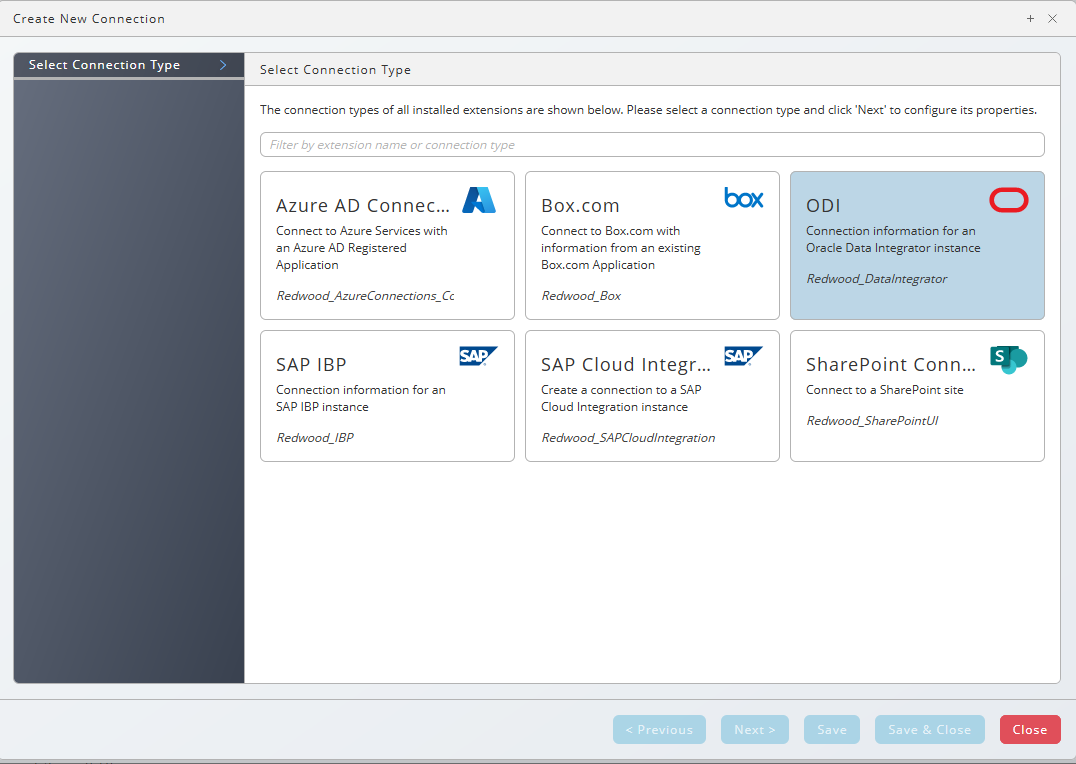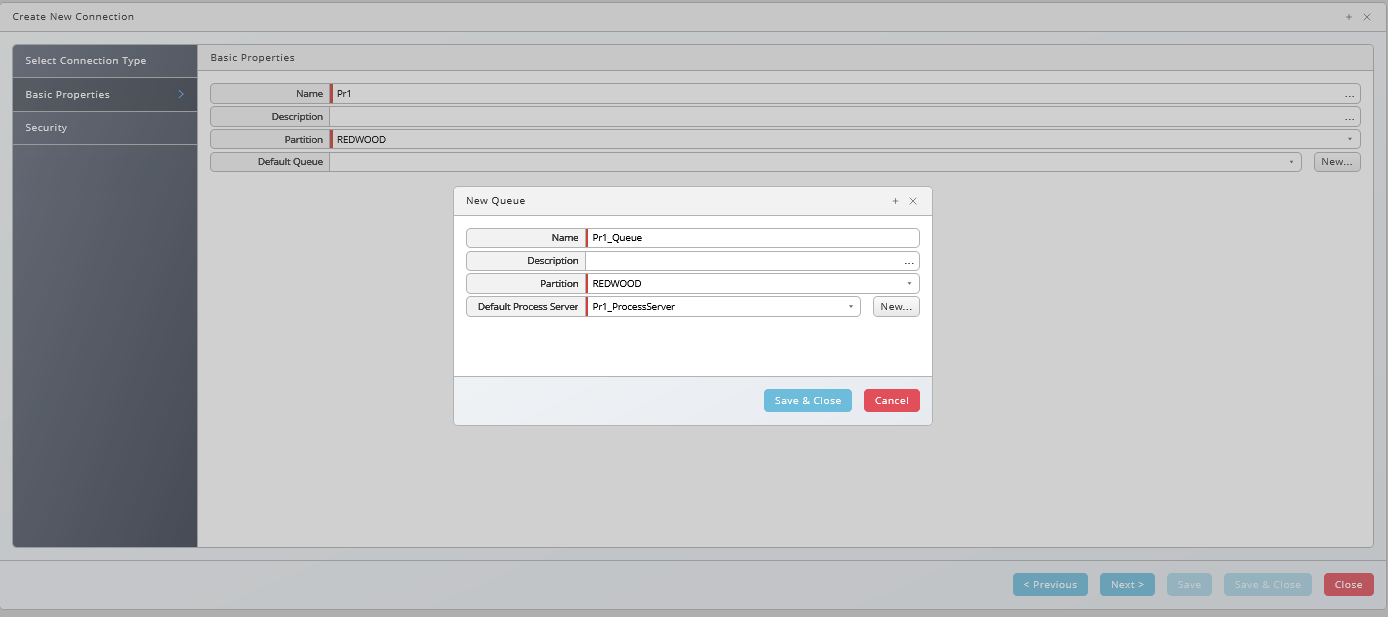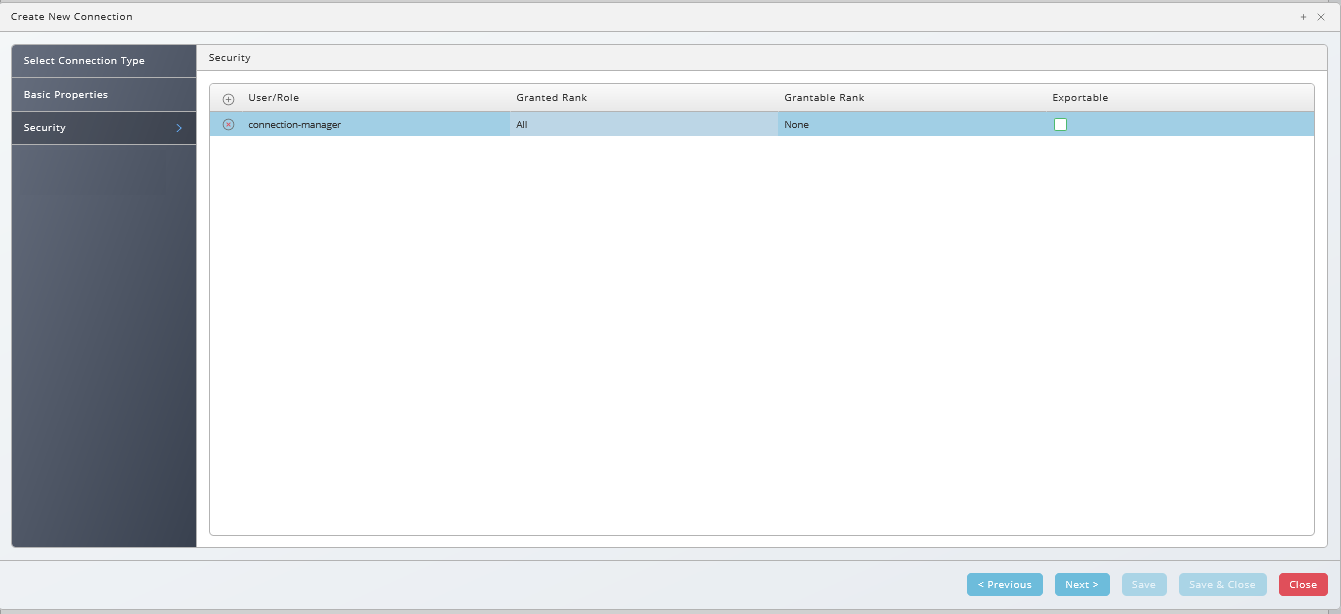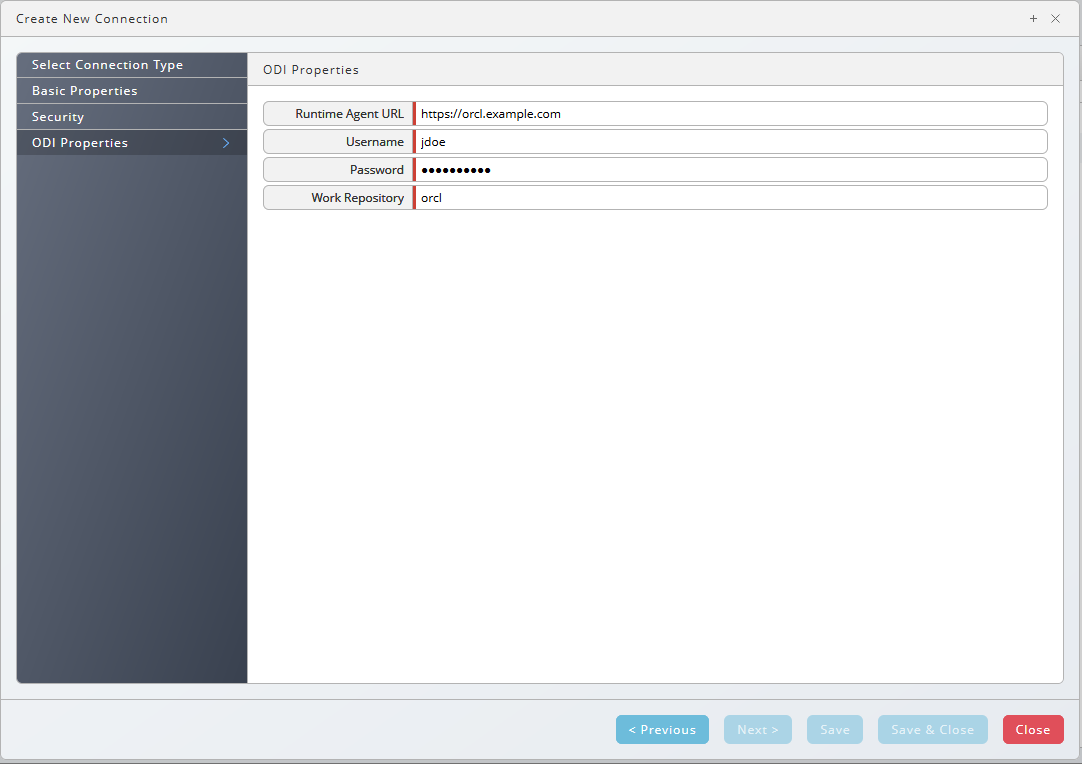Oracle Data Integrator
This component allows you to use the powerful Redwood scheduling engine and integrate the running of Load Plans and Scenarios into existing workflows. For example, another job may be configured to write some data to a database, when the data is available, an ODI Load Plan or Scenario can be triggered to perform further processing or ETL on the data.
Prerequisites
- Version 9.2.9 or higher.
- Connections component (installed automatically).
- Privileges Required for ODI.
Installation
The ODI Connector is available in the Catalog.
- Navigate to Custom > Connections and choose
.

- Choose ODI under Select a Connection Type.
- Choose Next or Basic Properties, you create a queue and process server for your ODI connection, all required settings will be set automatically.

- Choose Next or Security, this is a screen for all components, choose
to specify which roles can access the connection information. It is recommended to grant the role at least the following additional privileges: View on the ODI process server, View Processes on the ODI queue, View on library Redwood_DataIntegrator, and Submit on any process definitions users with this role are to submit.

- Choose Next or ODI Properties, this is specific for the ODI component, you specify Runtime Agent URL, Username, Password, and Work Repository for your connection.

- Navigate to Environment > Process Server, locate your ODI process server and start it, ensure it reaches status Running.
Contents of the Component
| Object Type | Name | Description |
|---|---|---|
| Application | GLOBAL.Redwood.REDWOOD.DataIntegrator.$2 | Provides definitions to run ODI Load Plans and Scenarios |
| Process Definition | Redwood_DataIntegrator_RunLoadPlan | Run an existing ODI Load Plan |
| Process Definition | Redwood_DataIntegrator_RunScenario | Run an existing ODI Scenario |
| Process Definition | Redwood_DataIntegrator_LoadPlanTemplate | Template for running an existing ODI Load Plan |
| Process Definition | Redwood_DataIntegrator_ScenarioTemplate | Template for running an existing ODI Scenario |
| Constraint Definition | REDWOOD.Redwood_DataIntegrator_ODIConnectionConstraint | Constraint for Oracle Data Integrator Connection fields |
| Extension Point | REDWOOD.Redwood_DataIntegrator | Oracle Data Integrator |
| Process Definition Type | REDWOOD.Redwood_DataIntegrator | Oracle Data Integrator Process Definition |
| Library | REDWOOD.Redwood_DataIntegrator | Oracle Data Integrator Library containing all dependencies |
Redwood_DataIntegrator_RunLoadPlan
Run an existing ODI Load Plan and monitor until completion.
This process definition executes an existing ODI Load Plan and waits for completion. An exception is thrown and the process fails if any of the required parameters are not specified or if they do not evaluate to a valid value (e.g. specified load plan, context, etc do not exist). The process will complete in success if the Load Plan succeeds. If the Load Plan execution fails, the process will complete in failure with a return code of 1. If the Redwood process is killed while the Load Plan is still running, it will issue a cancel command to ODI to attempt to cancel the Load Plan.
Input Parameters
| Name | Display Name | Description | Type | Required |
|---|---|---|---|---|
connection | Connection | The name of the Connection object that defines the connection the desired ODI Work Repository. Provides a drop down list of all available ODI connections from the Connection Management app. The user picks the name of an existing ODI Connection that has been defined in the connections app. | String | Yes |
loadPlan | Load Plan Name | The name of the existing ODI Load Plan to run. | String | Yes |
context | Context | The execution context to start the session in. | String | Yes |
logLevel | Log Level | The log level to set for the ODI session. All tasks with a defined log level that is lower than this value will be kept in the session log when the session completes. Accepts a single-digit value from 0-6 that indicates the level of logging to keep after the session completes. All tasks with a defined log level that is lower than this value will be kept in the session log when the session completes.; defaults to 5. | String | Yes |
keywords | Keywords | A comma-separated list of keywords to attach to the session. Takes a comma-separated list of keywords to attach to the session. This is used to help identify the session. | String | no |
variables | Variables | A comma-separated list of key=value pairs where the key is the name of a project or global variable and the value is the value to provide to that variable for the session. | String | no |
Redwood_DataIntegrator_LoadPlanTemplate
Template for running an ODI Load Plan
This definition is a template to allow users to create definitions that run specific Load Plans. It has the same parameters and functionality as the RunLoadPlan definition, but it is marked as a template.
Exposing Variables as Parameters
The template allows the user to expose individual variables as job parameters. To expose a variable as a job parameter after cloning the template, the user can create one or more parameters with the name prefix PAR_, and assign them to a parameter group named Parameters. At runtime, any parameters matching these characteristics will be sent to the Load Plan as variables. For example, if a parameter is named PAR_Variable1 and its value is set to Test, a variable called Variable 1 with the value of Test will be sent to the Load Plan at runtime.
Redwood_DataIntegrator_RunScenario
Run an existing ODI Scenario and monitor until completion.
This process definition executes an existing ODI Scenario and waits for completion. An exception is thrown and the job fails if any of the required parameters are not specified or if they do not evaluate to a valid value (e.g. specified load plan, context, etc do not exist). The job will complete in success if the Scenario succeeds. If the Scenario execution fails, the job will complete in failure with a return code of 1.
Input Parameters
| Name | Display Name | Description | Type | Required |
|---|---|---|---|---|
connection | Connection | The name of the Connection object that defines the connection the desired ODI Work Repository. Provides a drop down list of all available ODI connections from the Connection Management app. The user picks the name of an existing ODI Connection that has been defined in the connections app. | String | Yes |
scenarioName | Scenario Name | The name of the existing ODI Scenario to run. | String | Yes |
scenarioVersion | Scenario Version | The version of the Scenario to run. Specifying Latest (default) will run the latest version. The version of the scenario to run. When Latest is specified, the code will pass a value of -1 to the web service which tells it to run the latest version of the scenario. | String | Yes |
context | Context | The execution context to start the session in. | String | Yes |
logLevel | Log Level | The log level to set for the ODI session. All tasks with a defined log level that is lower than this value will be kept in the session log when the session completes. Accepts 0-6, defaults to 5 | String | Yes |
sessionName | Session Name | The name to use to identify the session that the Scenario runs in. If omitted, the Scenario name will be used as the session name. | String | No |
keywords | Keywords | A comma-separated list of keywords to attach to the session. | String | |
variables | Variables | A comma-separated list of key=value pairs where the key is the name of a project or global variable and the value is the value to provide to that variable for the session. | String | no |
Redwood_DataIntegrator_ScenarioTemplate
Template for running an ODI Scenario
This definition is a template to allow users to create definitions that run specific Scenarios. It has the same parameters and functionality as the RunScenario definition, but it is marked as a template.
Exposing Variables as Parameters
The templates allow the user to expose individual variables as job parameters. To expose a variable as a job parameter after cloning the template, the user can create one or more parameters with the name prefix PAR_, and assign them to a parameter group named Parameters. At runtime, any parameters matching these characteristics will be sent to the Scenario as variables. For example, if a parameter is named PAR_Variable1 and its value is set to Test, a variable called Variable 1 with the value of Test will be sent to the Scenario at runtime.
